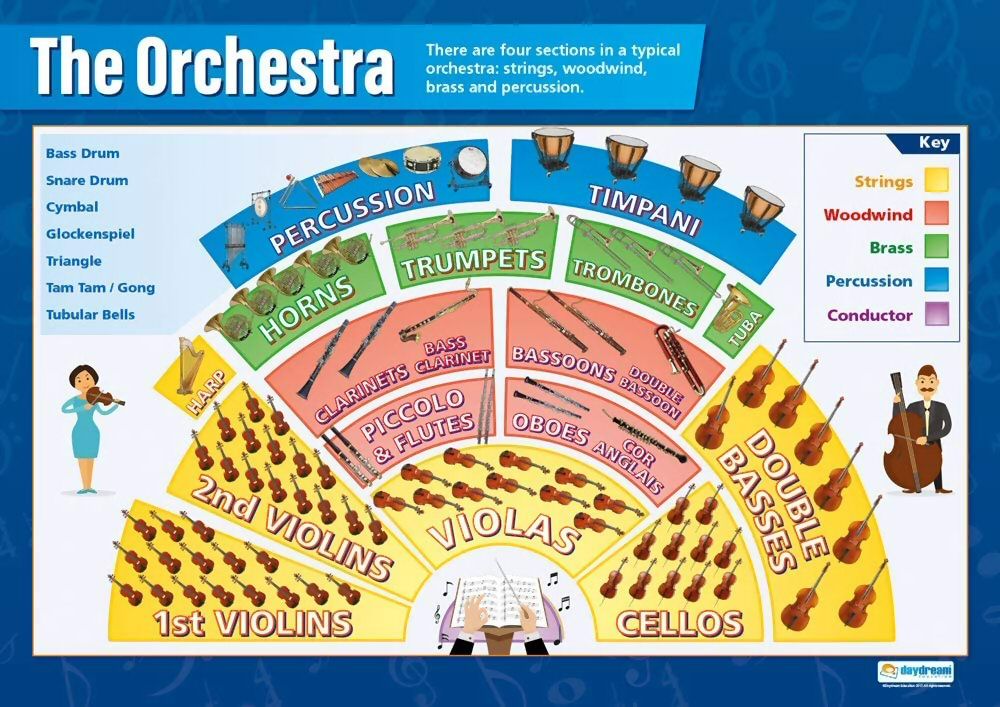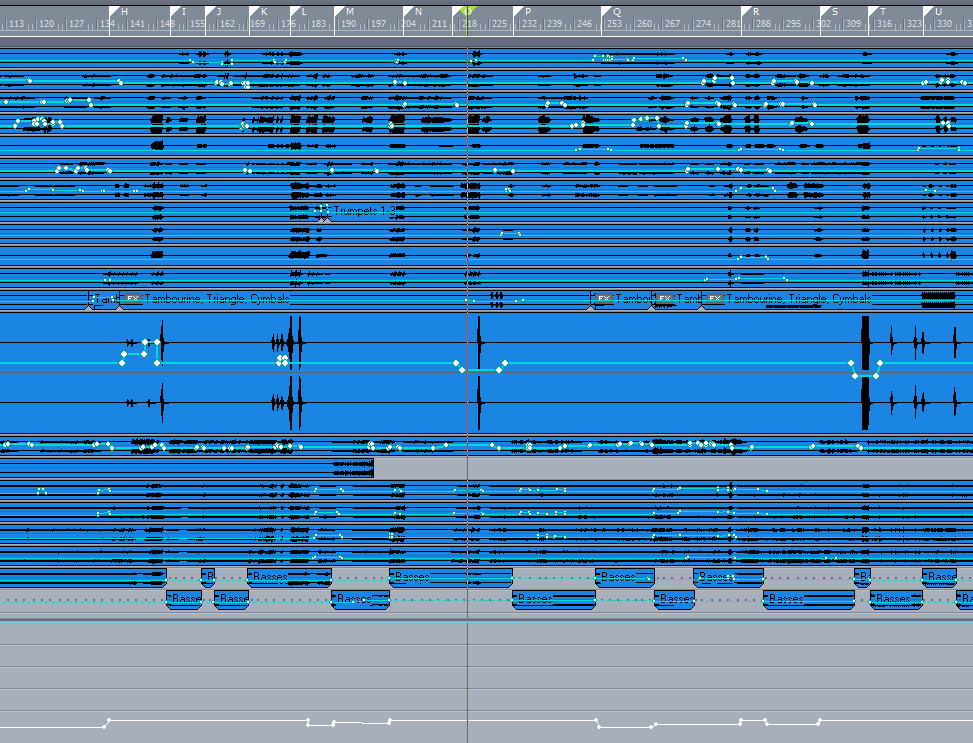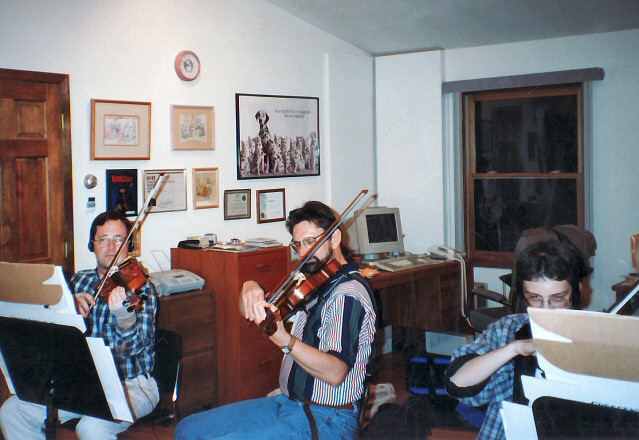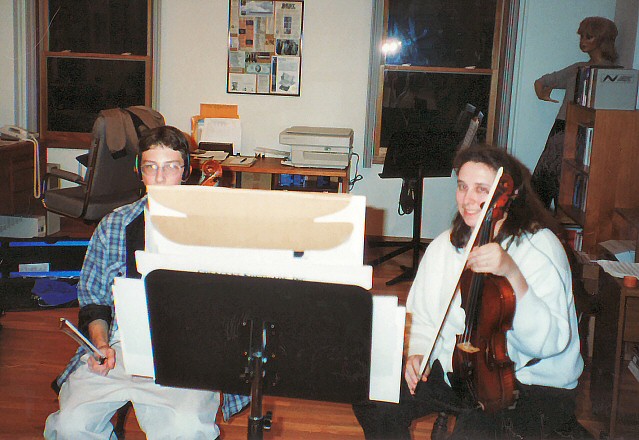 |
Ethan performing his cello concerto in 1999 with the Danbury Community Orchestra, maestro Richard Brooks conducting. |
This page contains information about my cello concerto. Here you will read how the concerto came to be written and recorded in my home studio piece by piece, as first printed in the May, 1999 issue of Strings magazine. You can download an MP3 file of the concerto, and view photos of the recording sessions. You can also download the complete printed score, plus all of the individual printed music parts. Audio engineers who'd like to try their hand at mixing this piece can download all of the original recording session Wave files. The concerto lasts about 17 minutes, including the cadenza. I hope you enjoy it!
In the spring of 2020 I resurrected the original session recordings for two reasons: For several years I've wanted to try making a better and more realistic sounding mix, and I think I've accomplished that. But also, a friend suggested I make the original session files available to other audio engineers for mixing practice. There are many multi-track collections for pop and rock music, but none that I know of for a full-on orchestra recorded section by section. So I dug out the original software used to record this concerto, and exported all the individual track files for others to download and use.
For Cellists
On April 10, 1999 I recorded world-renowned cellist Steven Thomas, replacing my own amateur performance mentioned in the article below. A play-along version of the concerto is available on CD from Music Minus One (now Music Dispatch). Besides the concerto this CD includes Schubert's Ave Maria and THIS fun "pop music" version of St. Saens' Allegro Appassionato. Two versions of each piece are provided: complete performances with Steven Thomas as the soloist, and also play-along versions without the cello. The CD order number is 400423 available at Hal Leonard. Be sure to also see my cello page for play-along MIDI files you can download for free, plus articles of interest to cellists, and also information about the Bernard Greenhouse Cello Master Class videos I produced.
This concerto is copyrighted and registered with ASCAP. I'd be thrilled if any other cellists would perform it publicly, or make their own commercial recording. If you do, please let me know!
For Audio Engineers
Audio engineers who'd like to mix this piece can download the original Wave files, as well as pre-loaded starter templates for several popular multi-track recording programs. After you unZip the Wave and project files and open the project in your DAW of choice, you'll probably need to specify where the track Wave files reside. The full score is provided for reference, and each section's letter marker (A, B, C, etc) notes the equivalent time within the track Wave files. Since this is an audio-only project with no MIDI, there's no need for the DAW software to have tempo changes that match the music. The bar and beat numbers on the timeline are irrelevant, so you'll go by the score letter markers.
|
If your DAW is not listed in the table below, simply start a new project and import each Wave file to its own track starting at Time Zero. The score PDF shows a typical instrument order from top to bottom: piccolo, flutes, oboes, etc. Then add the score letter markers to the timeline as shown in the lower image at left. If you'd like to help others using the same DAW as you, please send me your project file before you do anything else and I'll add it to the table below. And if you have any problem loading one of the provided templates, please let me know by emailing me from my home page.
As explained in the original article from Strings magazine reprinted below, this piece was recorded in sections. So the musicians heard a MIDI mockup and click track as they played, rather than other musicians as happens when recording everyone playing together at once. So besides making the recording sound "good" while mixing, and like a recording of a real orchestra, you also need to ensure that the solo cello, and internal melodies and counter-melodies, are clear and loud enough. And that no background parts are too loud either. You are literally the conductor dictating every player's dynamics. As with close-mic'd pop music, you'll probably find that low-cut filtering to counter microphone proximity effect is useful with these recordings too.
The top figure at left show a typical orchestra layout, though I didn't follow this layout exactly for my own mix. Note that compressors are rarely used with classical music, though I employed quite a bit of volume automation in my mix, sometimes on individual notes. The lower image at left shows an example of the automation I employed. The string bass tracks are at the bottom, with one Wave file containing both bowed (arco) and plucked (pizzicato) notes, alternating at various places. I separated out the pizzicato parts and put them on a new track in order to EQ them separately. So you might consider doing the same.
Most of this project contains recordings of real musicians, recorded as shown in the photos below. But a few of the instruments are samples played via MIDI when I couldn't get good enough players. The string basses, French horns, percussion, and tuba are samples. The bassoon was performed live, then I recorded the bassoonist playing individual notes at soft and loud volume to create a sample set for use in other projects. In the end I used those samples instead of his original performance. The clarinets are all live except two small spots where the player couldn't quite keep up. So MIDI samples were inserted for just those short sections. Likewise, the oboes are all live except for one short difficult spot near the end of the piece. So again MIDI samples were inserted into the track Wave file.
Special thanks to Andrew Hall for urging me to make the session files available to others for mix practice, and for creating the various DAW "starter" project files below. Thanks also to Peter Hodgson for his great advice and technical skills.
| Play Concerto | |
| MP3 file (23 MB) | This is the 2020 re-mix of the recording made in my home studio in 1999 |
| YouTube Link | This video version features scrolling music, for fun following along. |
| Download Sheet Music | |
| Zip file (2.2 MB) | This holds a PDF file of the complete printed score |
| Zip file (620 KB) | This holds a PDF file of the printed solo cello part |
| Zip file (6.4 MB) | This holds a PDF file of the rest of the printed orchestra parts |
| Download Audio Sources | |
| Link file (1 GB) | This links to a Zip file with all of the track Wave files |
| Link to Cambridge site | This audio forum lets you upload your mix for others to hear |
| Zip file (19 KB) | Project files for Pro Tools |
| Zip file (508 KB) | Project files for Logic |
| Zip file (18 KB) | Project files for SONAR 8 |
| Zip file (65 KB) | Project files for Cakewalk by BandLab |
| Zip file (408 KB) | Project files for Cubase |
| Zip file (5 KB) | Project files for Reaper |
| Zip file (49 KB) | Project files for Ableton Live |
| Zip file (19 KB) | Project files for Studio One 4 |
Writing a Romantic Cello Concerto in 1998, article from Strings Magazine May, 1999
My musician friends expressed concern when I told them I was writing a cello concerto in the romantic style. For reasons I can't understand, many players and composers these days have abandoned traditional musical values in favor of pieces that change meter every third measure, or contain excessive dissonance that never resolves. Perhaps I'm just stuck in the 19th century, but I greatly prefer music that has a melody and harmony, and strives for beauty rather than shock or sound effects.
 |
Ethan performing with the Danbury Community Orchestra in 1999. |
The occasion for this concerto, which is written as one long movement, was my debut as a soloist. In seven years of playing the cello I have performed many short works at recitals but never a real concerto with full orchestra. I had written two other pieces - one has been performed by four different area orchestras - and I decided that, if nothing else, it would be a lot more rewarding to play my own concerto than a piece from the standard literature. The biggest problem was to write something with sufficient musical value, yet not so difficult that I couldn't play it myself! What began as a fun project turned into nine long months of composing, plus considerable effort to typeset the score and 26 parts.
|
Like many composers today, I use an electronic keyboard and MIDI sequencer program to record each part. Once the notes are in the computer, it is simple to change the melody or harmony, or try a passage an octave higher or lower, or maybe move a line from the flutes to the oboes to see which sounds better. It is indeed wonderful to be able to hear a perfect performance of a work in progress without the expense of hiring an orchestra. Synthesizers are always in tune, and they never miss an entrance. Further, all modern sequencers can export the notes into a music typesetting program (though you still have to add the slurs, bowings, and dynamic markings, and plan the page turns). This ensures that the notes you wrote make it to the score and parts without any errors. The inevitable downside, however, is that a performance by an orchestra of synthesizers sounds decidedly phony. When I played my finished concerto for a violinist friend, his first comment was, "Nice job. Was that supposed to be a French horn?" At that moment it became painfully obvious that I would need a real recording with live musicians if I ever hoped to convince a record company or well-known cellist that my concerto has merit.
My first thought was to hire a professional orchestra. Let's see, a conductor and a soloist, plus 60 musicians at maybe $120 each comes to...oops! Then I considered recording one of the local groups I play with. But it seemed unlikely that a bunch of mostly amateur players and students could get through this fairly complex piece without any major gaffs. My solution was to get the few best amateur players I know - plus some pros who owed me a favor - and record them one by one (woodwinds and brass) and in groups (strings), and mix the performances on my computer-based audio recording system. By recording the players separately, I could focus on each part and redo passages on the spot as needed. A lot of nonclassical music is recorded using overdubs, and I'm happy to report that this method was equally successful for recording my concerto. Nobody is likely to confuse my "virtual orchestra" with the New York Philharmonic, nor my amateur playing with that of an accomplished cellist, but the performances are real and the musical intent shines through clearly. Equally important, using friends and accomplished amateurs let me record the entire project for only a few hundred dollars.
|
Each part was recorded in a separate session in my acoustically designed home studio. For maximum quality and realism, I recorded the players in stereo using professional-quality microphones. The musicians all wore earphones and played along with the original synthesizer version of the piece. There were a few passages that rushed or dragged a little, made worse by their having to follow the existing music aurally as opposed to watching a conductor. Fortunately, the players rushed and dragged as a group, and during editing I was able to slide phrases and even individual notes forward or back in time a few milliseconds here or there as necessary. I use the SAW Plus computer-based multitrack recording software, which makes detailed sound manipulation like this very easy. It was also simple to raise and lower the volume in places to enhance crescendos, and tone down a few passages that were played with a bit too much enthusiasm. For the occasional out-of-tune notes, I used the pitch correction feature of Sound Forge 4.5, another excellent audio editor program. With Sound Forge you can adjust the pitch of a single note or an entire passage in a computer audio file, to make the intonation exactly correct but without affecting the musical timing.
Performance Notes
I have tried to make my intent for fingerings and phrasing as clear as possible in the printed music, including alternate fingerings where appropriate. Several of my teachers and friends contributed to the fingerings and bowings, including Steven Thomas, Kate Dillingham, Andy Salvo, and Andy Woodruff. A few additional points are worth noting.
1) In several places there are notes with legato lines that should not only be played longer than normal, but should also begin slightly early to give an added emphasis. The pickup note into section "C" is one such example, as are the pickups to "I" and "P" and the entrance at "D."
2) The 8va option in section "G" sounds much higher than the clarinet line that precedes it, but if you can pull it off it should sound terrific in that register.
3) The Animato section starting at "T" should be played as fast you can reasonably handle, in much the same spirit as the third movement of the Haydn C Major concerto. The orchestra is pretty much coasting there, though bear in mind that the solo oboe doubles the cello in "U" and must be able to keep up.
4) There are two places in the cadenza that a slight pause will give a nice added emphasis just before the changes in tonality. One place is the G# in measure 30, which should be held a bit longer than normal. The other is the middle of measure 43, where you could hold the G slightly before playing the Ab that follows.
Finally, you may be amused to know that I hid a little love message to my wife as Morse code, which is embedded in the rhythm played by the brass and strings in measure 296. After all, this is a Romantic piece!
Ethan Winer is a reformed rock ‘n’ roll guitarist who started playing the cello in 1992 at the tender age of 43. He produced the "Cello Master Class" videos featuring Bernard Greenhouse and also four cello CDs for Music Minus One. Ethan has, at various times, earned a living as a studio musician, computer programmer, audio engineer, composer/arranger, and technical writer. He lives in New Milford, Connecticut, and plays the cello in the Danbury Symphony Orchestra.
This article appears in the May 1999 issue of Strings Magazine, a most worthwhile publication for all string players. For information or to subscribe visit their web site at stringsmagazine.com.
View the recording session photos!
Click the photos below to see them full size. (Not shown: Andy Salvo, cello; Bob Harris, clarinet)
 |
 |
 |
 |
 |
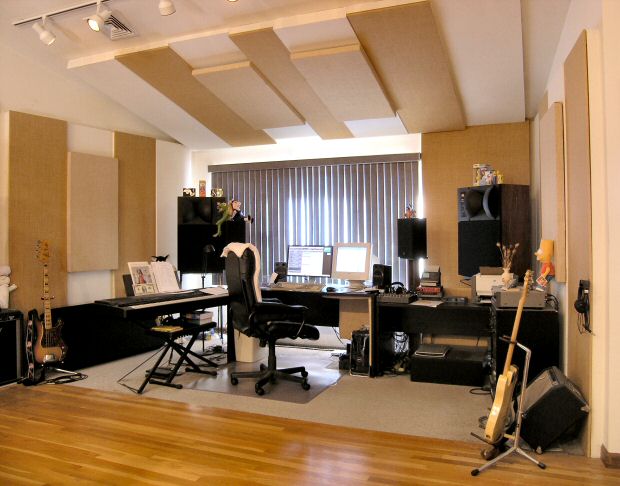 |
| Bob Lewis, bassoon samples | Kevin Sandler, trumpets |
Beth Nintzel, trombones |
Doug Ferrara, snare drum samples |
Ethan Winer, composer, engineer |
This is a more recent photo of the studio. |
What People are Saying...
Below are a few comments I received by email about my concerto when it was first released in 1999:"I spent a most enjoyable 20 minutes immersed in the video of your cello concerto. As a music graduate in my past I would have been more than happy to sit and analyze your contemporary composition instead of all the electro-acoustic modern meanderings of John Cage thru Stravinsky which we were reliably taught were the future of classical music. What a pleasant surprise to come across a true neo-romantic composition of such class in the middle of the World Wide Web. Kudos to you for committing your passion for 'real' music - soulful, intelligent, harmonic music - to paper, and thank you for sharing it with the world." --Tim Waddell
"I had to keep reminding myself I wasn't listening to Schumann...I thought it was one of the best cello concerti I've ever heard." --YAS
"Thank you for this highly enjoyable piece of music." --MB
"...Dvorak or St. Saens would have probably considered it a pretty good work." --SC
"I really like your concerto, it reminds me of the Elgar." --PL
"It was remarkable! Very fine job composing. A real Romantic masterpiece." --DY
"Each time I've listened to your Concerto I get more impressed with its construction!" --KI
The review below is from the Danbury (Connecticut) News-Times the day after my May 2, 1999 debut performance:
...Then came music that has just been composed. It was the world premiere of a cello concerto by Ethan Winer, the orchestra's principal cellist, who took the solo part. Bold, eclectic, accomplished, the piece turned out to be a rewarding experience for all concerned. Winer has written dance rhythms, attractive themes of a Russian cast, and elsewhere some measures that bring to mind composers such as Bach and Bernstein. He sounded in good form as a performer, too, and his cohorts served him well. This is a work that should have a future. --Frank Merkling, News-Times Arts Critic
There is also a very nice review at the Cello Heaven web site.
Hear Ethan's Interview on the RadioOn April 11, 1999 I was interviewed by Joanne Moryl on WMNR-FM to discuss the upcoming May 2 performance of my cello concerto. The interview went well and we talked about many other interesting topics, so I've made it available here as an MP3 file (43 MB).
